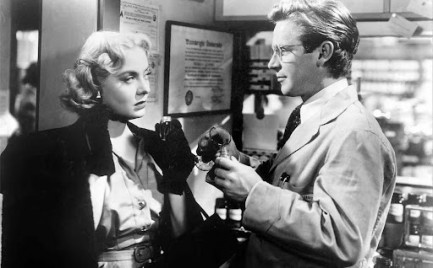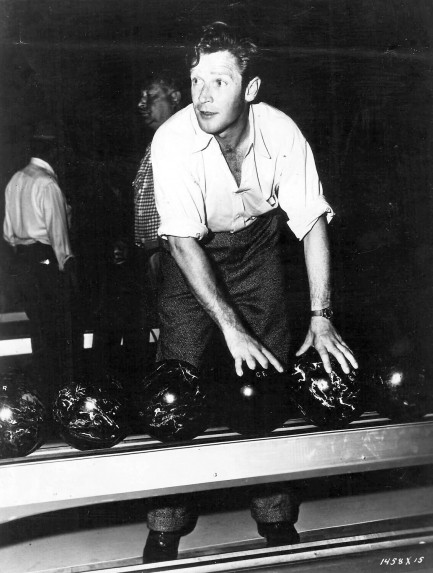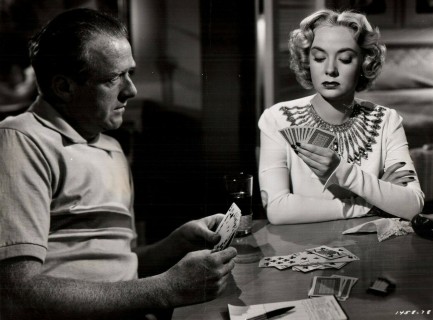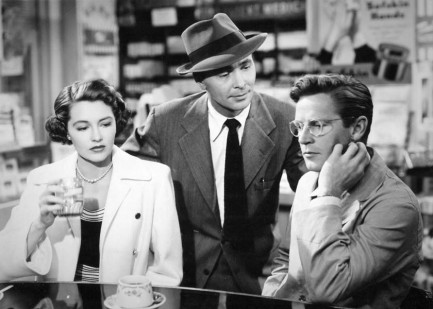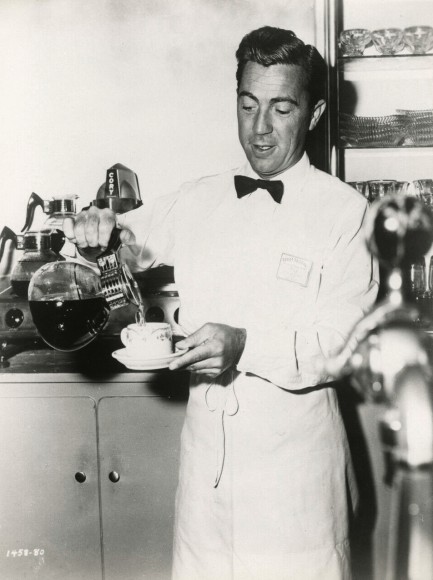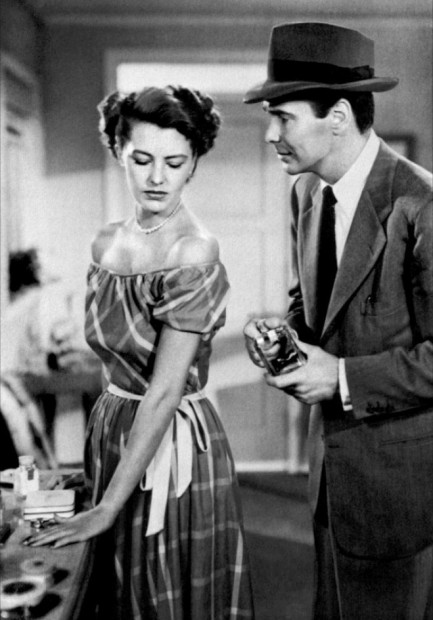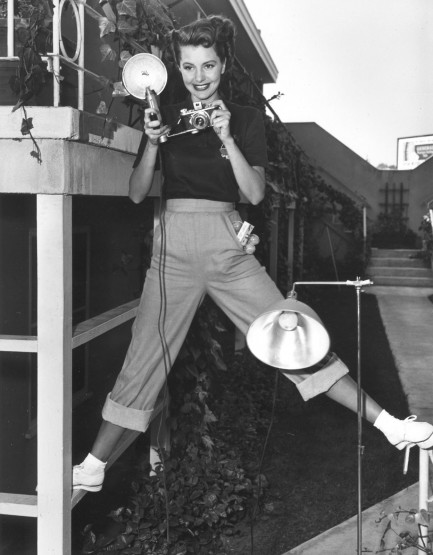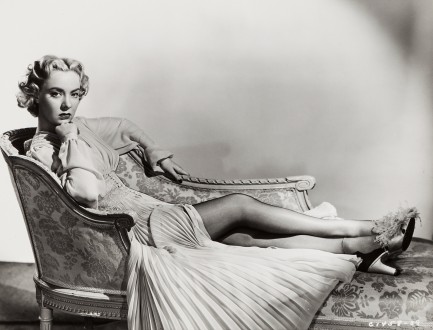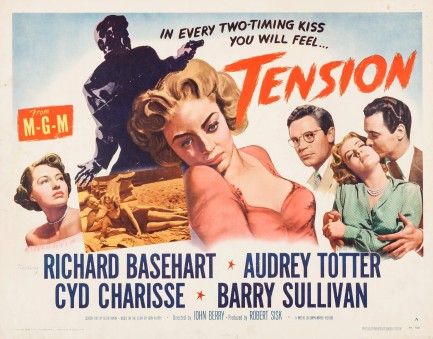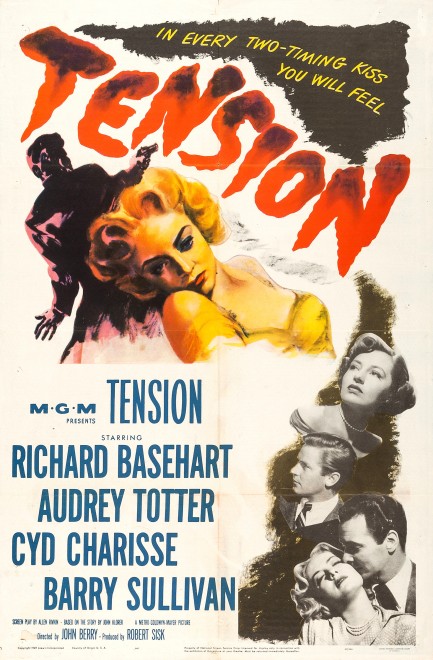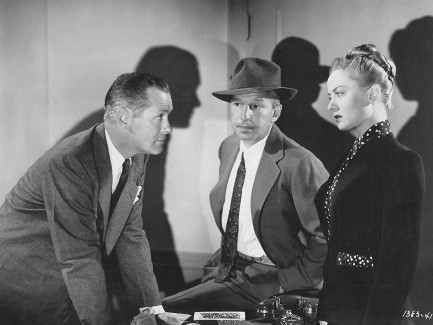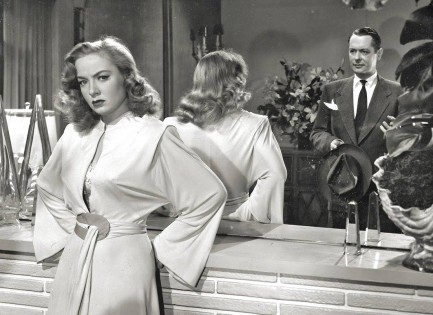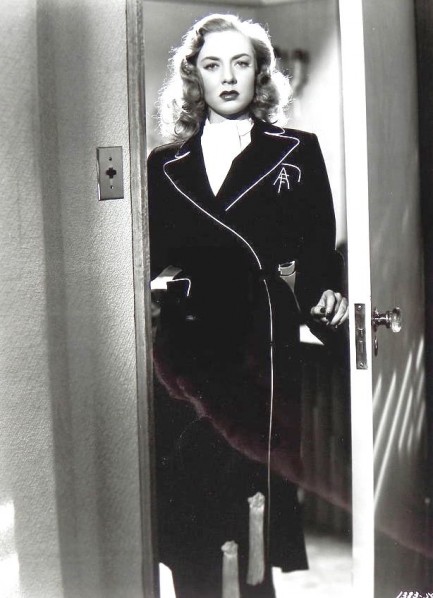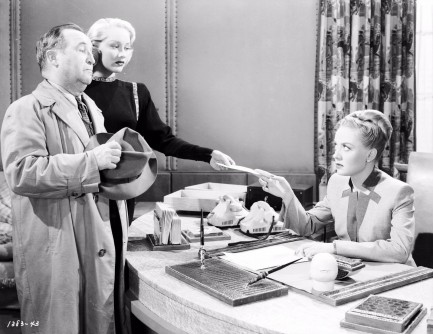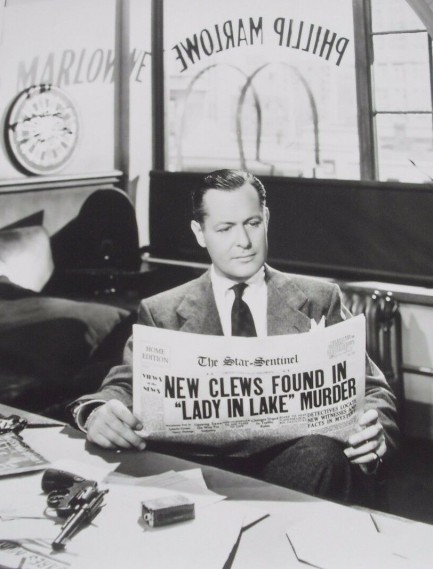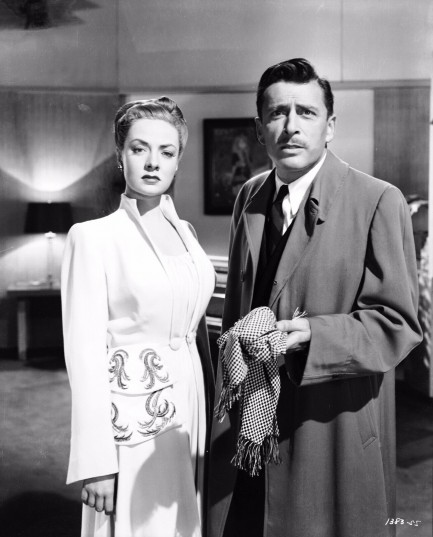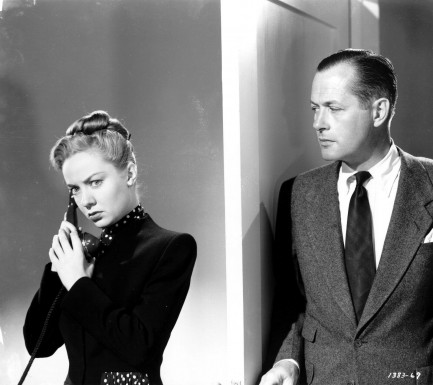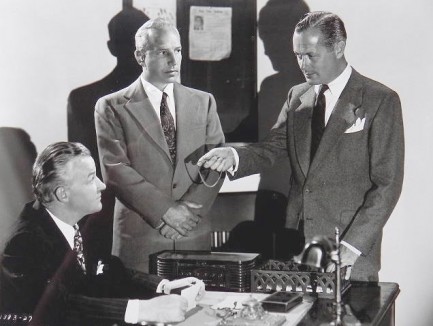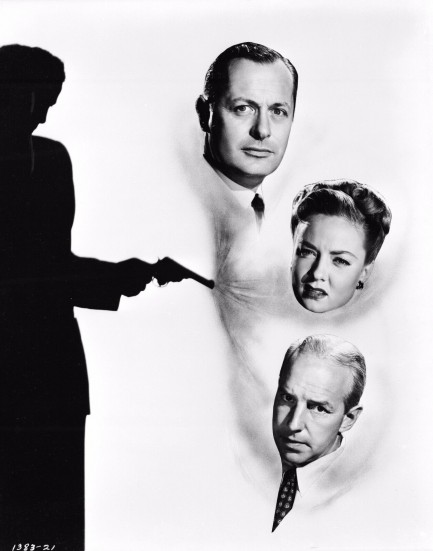 Give credit where credit is due—when possible. 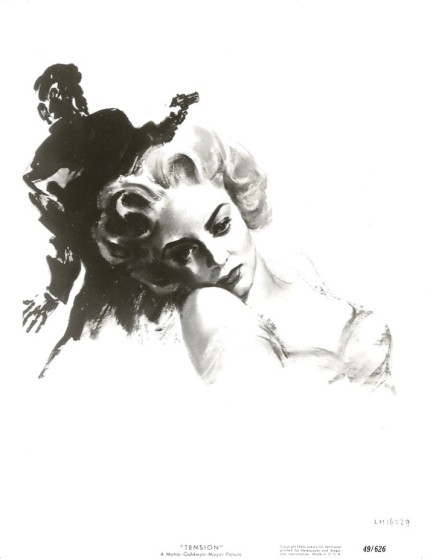
Above is an MGM promo handout for the film noir Tension, which starred Audrey Totter and hit cinemas today in 1949. It was painted in ink by the same person who did the poster, one of the greatest artists in cinema poster history—the inimitable uncredited. It's a great piece by a true master. We've shown you a lot of Tension's U.S. promo art, and today's doesn't even empty the well of what's out there, but it's the last time we'll dip into it. So many vintage films, so little time...
 Movie stars were always willing to give each other a hand. 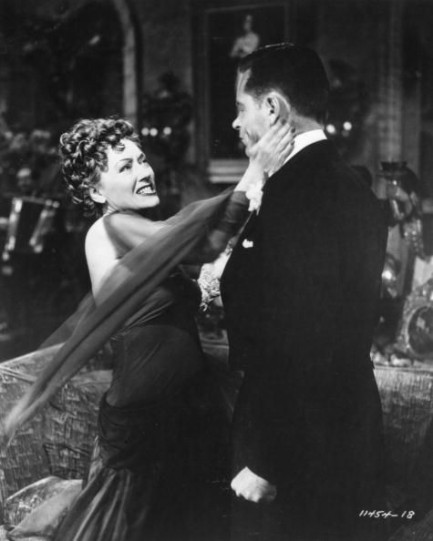
Once again we've been struck, so to speak, by the sheer number of cinema promo images featuring actors and actresses pretending to slap each other. They just keep turning up. The above shot is more about the neck than the face, but it still counts, as Gloria Swanson slaps William Holden in 1950's Sunset Boulevard. Below we have a bunch more, and you can see our previous collection at this link. Since we already discussed this phenomenon we won't get into it again, except briefly as follows: pretend slaps, film is not reality, and everyone should try to remember the difference. Many slaps below for your interest and wonder. 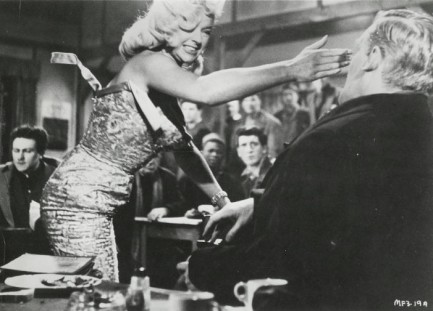 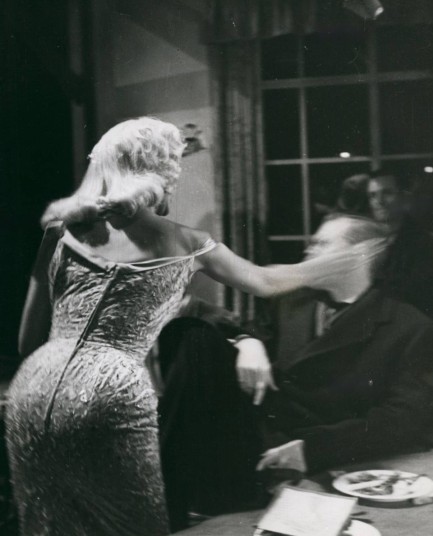 Diana Dors smacks Patrick Allen blurry in 1957's The Long Haul. Diana Dors smacks Patrick Allen blurry in 1957's The Long Haul.
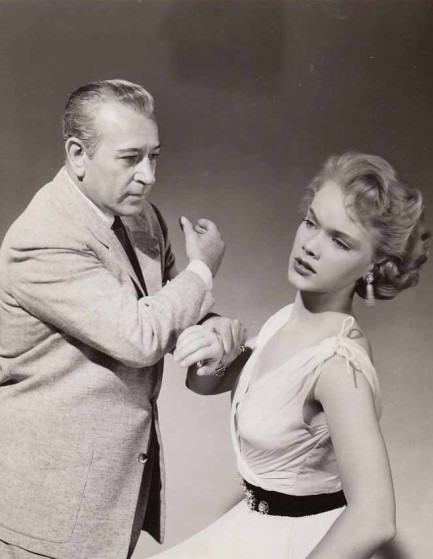 Mob boss George Raft menaces Anne Francis in a promo image made for 1954's Rogue Cop. Mob boss George Raft menaces Anne Francis in a promo image made for 1954's Rogue Cop.
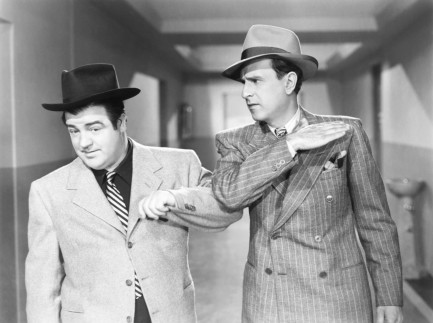 Bud Abbott gets aggressive with Lou Costello in 1945's Here Come the Co-Eds. Bud Abbott gets aggressive with Lou Costello in 1945's Here Come the Co-Eds.
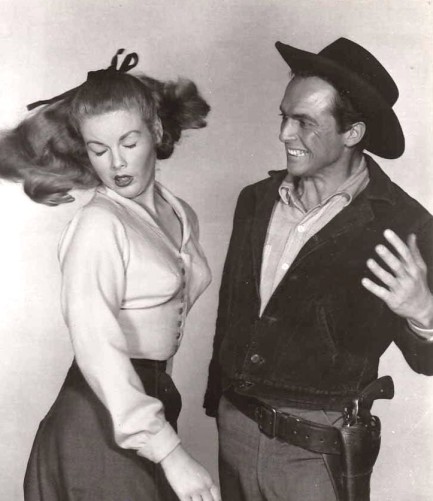 Jo Morrow takes one from black hat Jack Hogan in 1959's The Legend of Tom Dooley. Jo Morrow takes one from black hat Jack Hogan in 1959's The Legend of Tom Dooley.
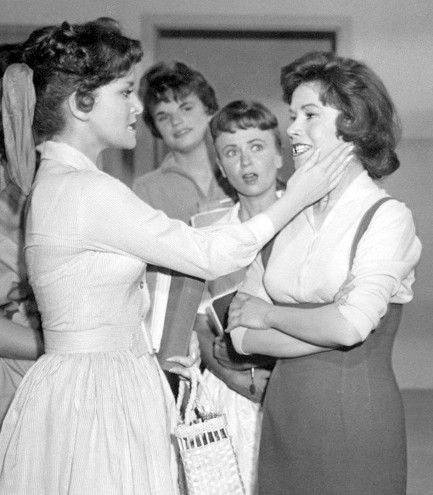 Chris Robinson and Anita Sands get a couple of things straight about who's on the yearbook committee in Diary of High School Bride. Chris Robinson and Anita Sands get a couple of things straight about who's on the yearbook committee in Diary of High School Bride.
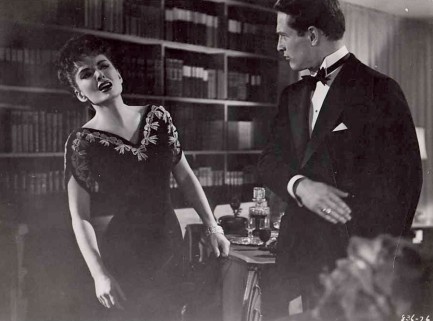 Paul Newman and Ann Blyth agree to disagree in 1957's The Helen Morgan Story. Paul Newman and Ann Blyth agree to disagree in 1957's The Helen Morgan Story.
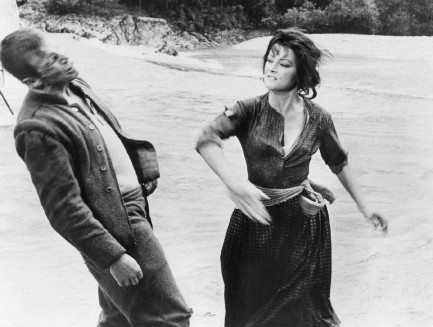 Verna Lisi shows Umberto Orsini who gives the orders in the 1967 film La ragazza e il generale, aka The Girl and the General. Verna Lisi shows Umberto Orsini who gives the orders in the 1967 film La ragazza e il generale, aka The Girl and the General.
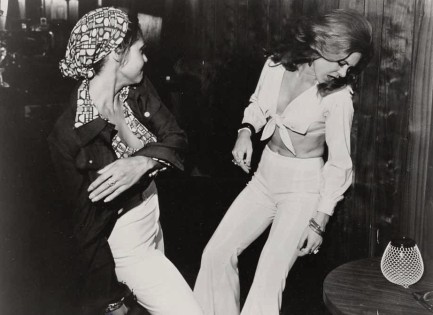 What the fuck did you just call me? Marki Bey slaps Betty Anne Rees loopy in the 1974 horror flick Sugar Hill. What the fuck did you just call me? Marki Bey slaps Betty Anne Rees loopy in the 1974 horror flick Sugar Hill.
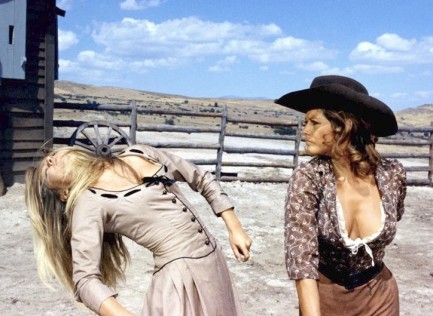 Claudia Cardinale slaps (or maybe punches—we can't remember) Brigitte Bardot in the 1971 western Les pétroleuses, known in English for some reason as The Legend of Frenchie King. Claudia Cardinale slaps (or maybe punches—we can't remember) Brigitte Bardot in the 1971 western Les pétroleuses, known in English for some reason as The Legend of Frenchie King.
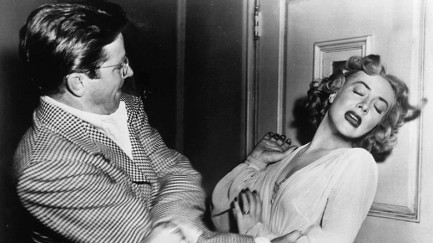 Audrey Totter reels under the attentions of Richard Basehart in 1949 Tension. We're thinking it was probably even more tense after this moment. Audrey Totter reels under the attentions of Richard Basehart in 1949 Tension. We're thinking it was probably even more tense after this moment.
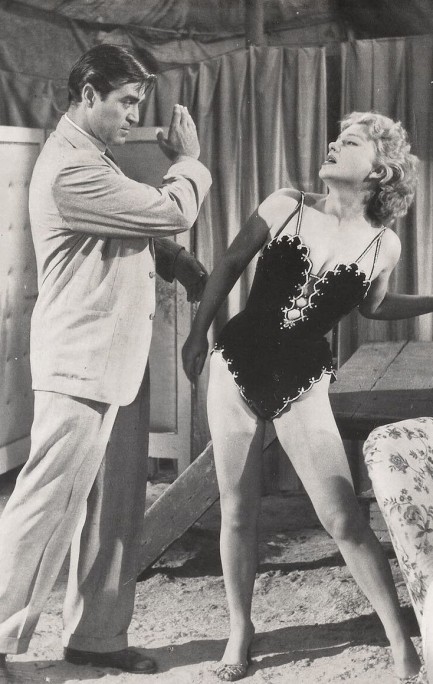 Anne Baxter tries to no avail to avoid a slap from heel Steve Cochran in 1954's Carnival Story. Anne Baxter tries to no avail to avoid a slap from heel Steve Cochran in 1954's Carnival Story.
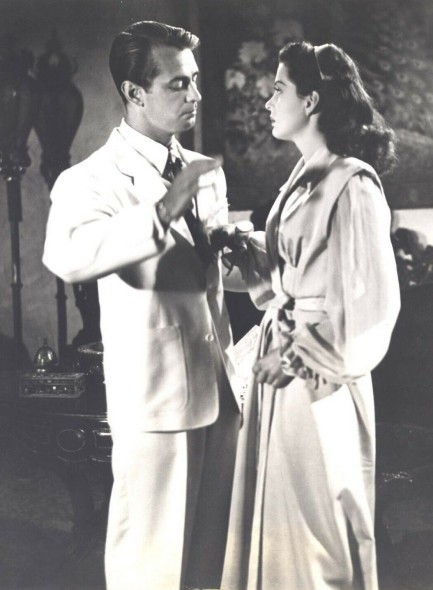 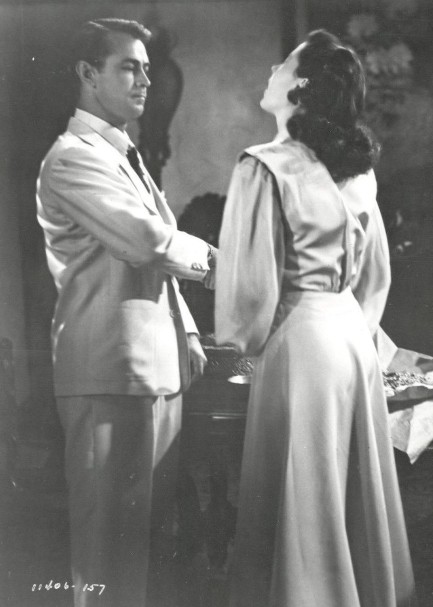 Though Alan Ladd was a little guy who Gail Russell probably could have roughed up if she wanted, the script called for him to slap her, and he obeyed in the 1946 adventure Calcutta. Though Alan Ladd was a little guy who Gail Russell probably could have roughed up if she wanted, the script called for him to slap her, and he obeyed in the 1946 adventure Calcutta.
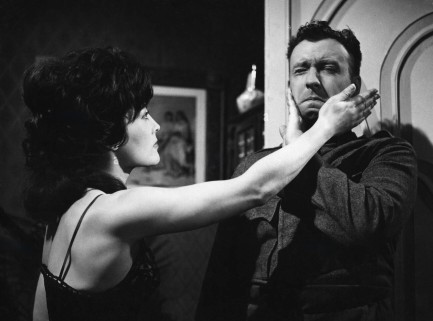 Peter Alexander guards his right cheek, therefore Hannelore Auer crosses him up and attacks his left in 1964's Schwejk's Flegeljahre, aka Schweik's Years of Indiscretion. Peter Alexander guards his right cheek, therefore Hannelore Auer crosses him up and attacks his left in 1964's Schwejk's Flegeljahre, aka Schweik's Years of Indiscretion.
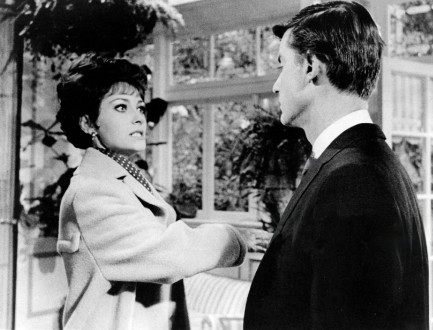 Elizabeth Ashley gives Roddy McDowall a facial in in 1965's The Third Day. Elizabeth Ashley gives Roddy McDowall a facial in in 1965's The Third Day.
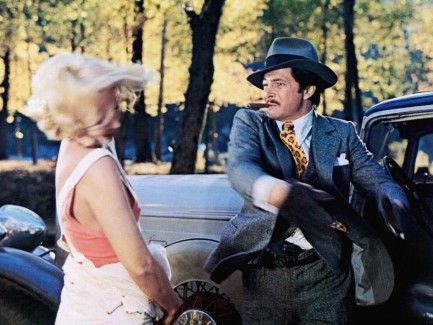 Tony Anthony slaps Lucretia Love in 1972's Piazza pulita, aka Pete, Pearl and the Pole. Tony Anthony slaps Lucretia Love in 1972's Piazza pulita, aka Pete, Pearl and the Pole. 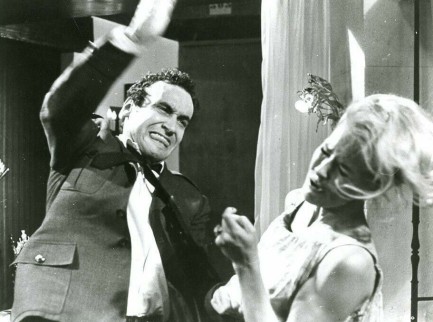 André Oumansky goes backhand on Lola Albright in 1964's Joy House. André Oumansky goes backhand on Lola Albright in 1964's Joy House.
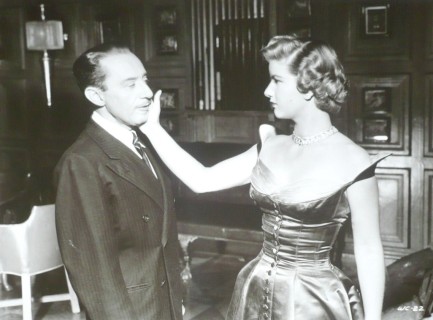 Frank Ferguson catches one from Barbara Bel Geddes in the 1949 drama Caught. Frank Ferguson catches one from Barbara Bel Geddes in the 1949 drama Caught.
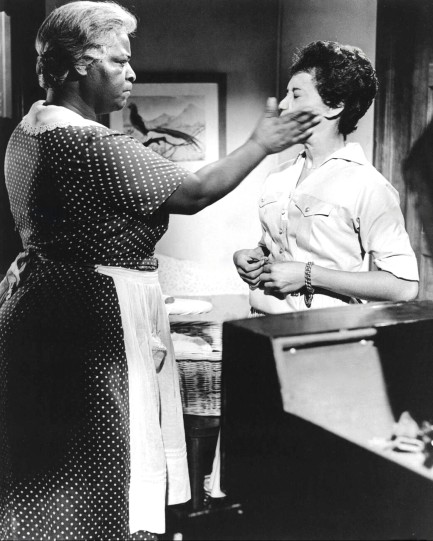 This looks like a real slap, so you have to credit the actresses for their commitment. It's from 1961's Raisin in the Sun and shows Claudia McNeil rearranging the face of Diana Sands. This looks like a real slap, so you have to credit the actresses for their commitment. It's from 1961's Raisin in the Sun and shows Claudia McNeil rearranging the face of Diana Sands.
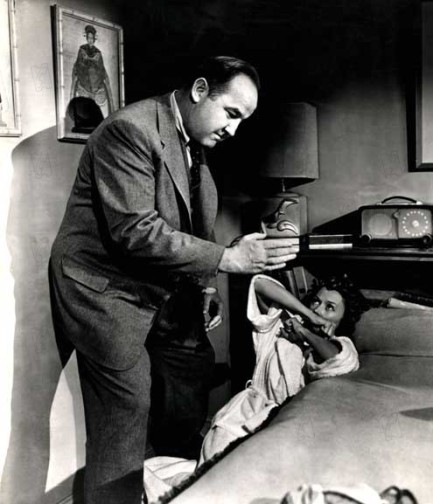 Gloria Grahame finds herself cornered by Broderick Crawford in 1954's Human Desire. Gloria Grahame finds herself cornered by Broderick Crawford in 1954's Human Desire.
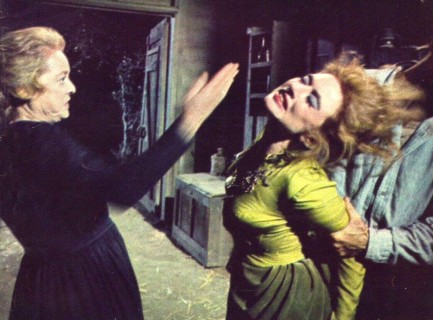 Bette Davis, an experienced slapper and slappee, gets a little assistance from an unidentified third party as she goes Old West on Amanda Blake in a 1966 episode of Gunsmoke called “The Jailer.” Bette Davis, an experienced slapper and slappee, gets a little assistance from an unidentified third party as she goes Old West on Amanda Blake in a 1966 episode of Gunsmoke called “The Jailer.”
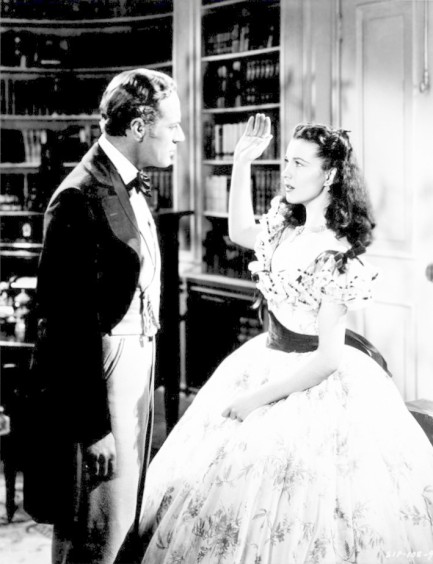 There are a few slaps in 1939's Gone with the Wind, so we had our pick. We went with Vivien Leigh and Leslie Howard. There are a few slaps in 1939's Gone with the Wind, so we had our pick. We went with Vivien Leigh and Leslie Howard.
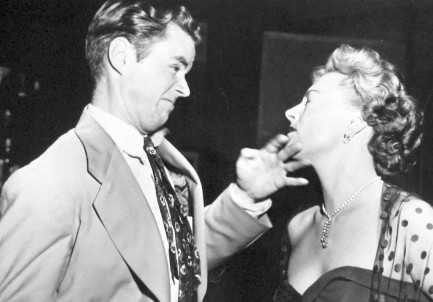 Virginia Field takes one on the chin from Marshall Thompson in Dial 1119. Virginia Field takes one on the chin from Marshall Thompson in Dial 1119.
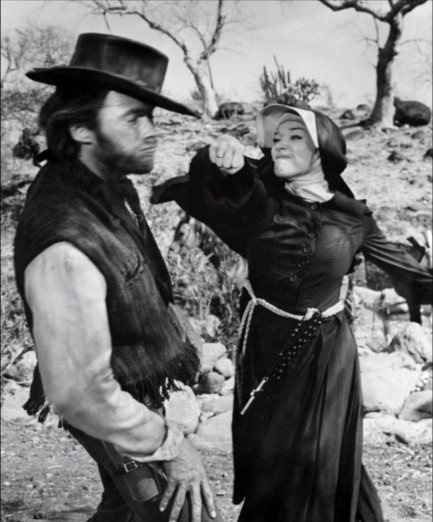 Clint Eastwood absorbs a right cross from nun Shirley MacLaine in 1970's Two Mules for Sister Sara. Clint Eastwood absorbs a right cross from nun Shirley MacLaine in 1970's Two Mules for Sister Sara.
 At this point she has no idea which way to turn. 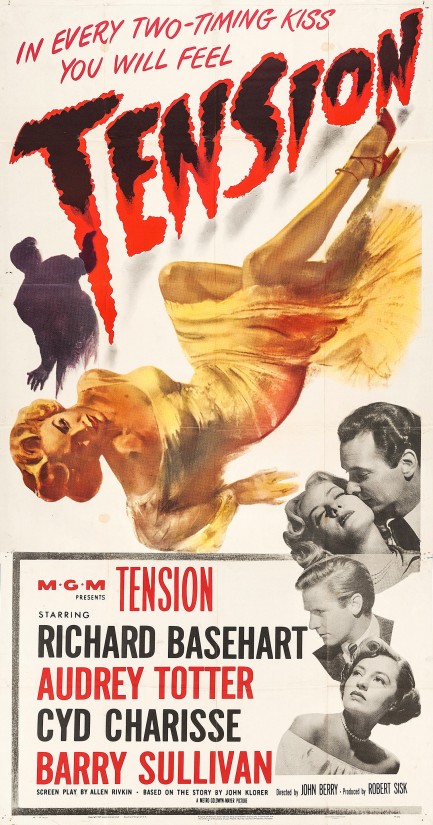
Above is an alternate promo poster for Tension, with cool upside down imagery of a figure representing star Audrey Totter. We say “representing” because it doesn't really look like Totter, but it's her alright. It was modeled after a promo photo. The movie also starred Richard Basehart and the incandescent Cyd Charisse. We talked about this last year, so if you want to know more, click here. And if you want to see more of Totter click here, or Charisse (a must), click here and here. Tension premiered today in 1949.
 They call it maximum security to scare you. I still get hair dye, cigarettes, good shoes, and pedicures, so I'm all good. 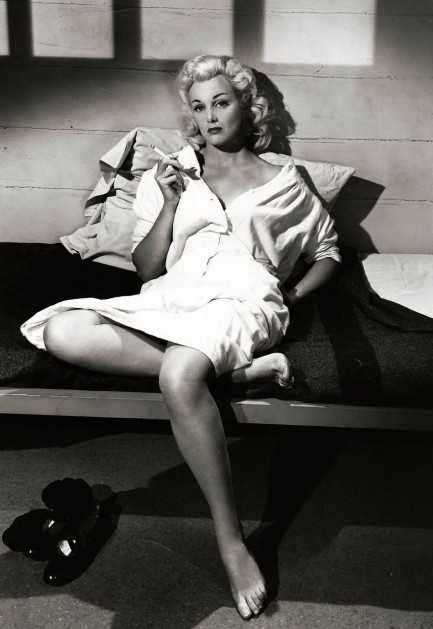
Let's circle back to Jan Sterling, shall we? As you know, she's become a favorite actress of ours, and since she has a number of excellent promo images we might as well run through a few. This one was made for her 1955 drama Women's Prison, in which her co-stars were Ida Lupino, Audrey Totter, and Cleo Moore. Think we'll be watching that? Well, with three great film noir icons in the cast, along with Sterling herself as one of the most elegant felons ever, you can bet on it.
 Anyone can be calm until the cops start poking around. 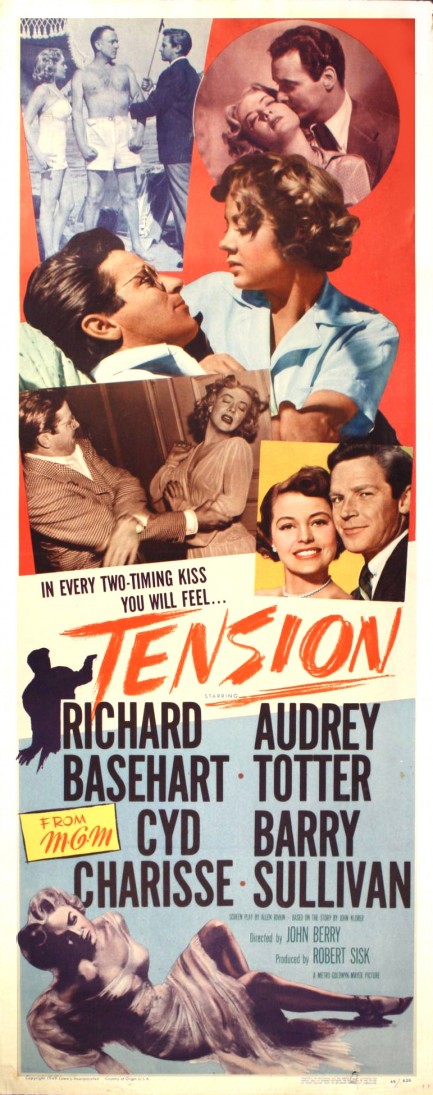
Tension, for which you see an excellent promo poster above and two more below, is an unlikely but interesting film noir about a mild mannered pharmacist played by Richard Basehart, who's married to hot-to-trot Audrey Totter and discovers she's cheating on him. When she finally leaves him for an apelike creature played by Lloyd Gough, and the ape issues Basehart a solid beating, he decides he's been pushed too far. You'd think that pharmacists would be among that select group of people you really don't want to anger, but this particular pharmacist has a much more elaborate scheme in mind than just a dose of chemicals, and his determination to commit an untraceable murder leads to him building a very traceable double life. In that second life things get complicated when he meets lovely Cyd Charisse, who he wants to make a permanent addition to his future.
Basehart's plot will not go as intended, of course, but the way in which it fails is a surprise, and the complications keep piling up. Tension has flaws, to be sure. The detective played by Barry Sullivan does things that, as far as we know, would get any murder case tossed out of court, but you have to go with it, since he tells you from the jump he'll do anything to solve a case. The plusses of the movie outweigh any weird bits, and with Totter on board, it's probably a must-see. The sinuous clarinet melody she gets every time she appears onscreen is over-the-top, but she's a major scenery chewer anyway, so it actually fits. We didn't like her in Lady in the Lake, but she's delivered in everything else we've seen—this flick, particularly. And Charisse, by the way, gets one of the better entrances we've seen in vintage cinema, straddling two high railings with a camera in hand. She's as hot as a human being can get. Tension premiered today in 1949.
 For your own good trust nobody. 
Above: a poster for the thriller The Unsuspected, a movie you apparently can't foresee or forget, starring Claude Rains, Joan Caulfield, Audrey Totter, and Constance Bennett, directed by Michael Curtiz of Casablanca fame. We shared two nice Italian posters for this, and talked about it in detail. Check here, if interested. The Unsuspected premiered in the U.S. today in 1947.
 Philip Marlowe tries not to go under for the third time in Lady in the Lake. 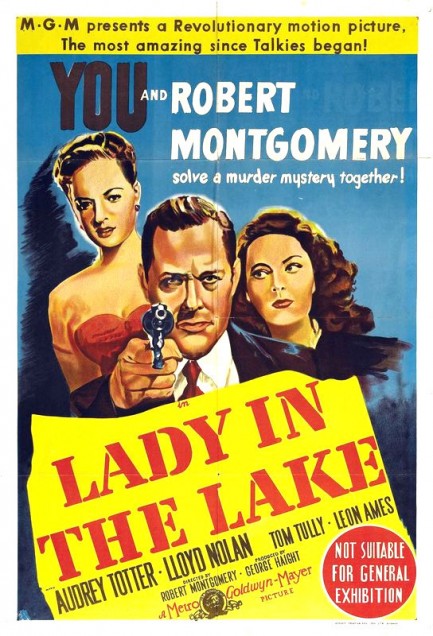
Lady in the Lake, for which you see a promo poster above, was the first motion picture shot almost entirely from the visual perspective of a single character. That character is Raymond Chandler's iconic private dick Philip Marlowe, played by Robert Montgomery, who also directed. As both a mystery and a seeing-eye curiosity, this is something film buffs should check out. You won't think it's perfect. Montgomery's version of Marlowe regularly crosses the line from hard-boiled to straight-up asshole, but that's the way these film noir sleuths were sometimes written.
Though the bad attitude is tedious at times, the mystery is interesting, there's plenty of directorial prowess on display from Montgomery, and a bit of unintentional comedy occurs when he gets knocked cold twice in that first person p.o.v. Seriously, Marlowe, you couldn't see those punches coming? We were reclined on the sofa with glasses of wine in our hands and we could have dodged them without spilling a drop. It's all in good fun, though. Every shamus gets forcibly put to sleep now and again.
If the movie has a major flaw it's that co-star Audrey Totter gives a clinic in overdone facial expressions before overcoming these bizarre poker tells to finally settle into normal human behavior around the halfway mark. Despite that bit of weirdness, film noir fans will like this. Those new to the genre maybe will find it too strange to fully enjoy. But it's indisputably a landmark, and that's worth something. Lady in the Lake premiered in London in late 1946, and went into general release in the U.S. today in 1947.
 It's always the person you least suspect. 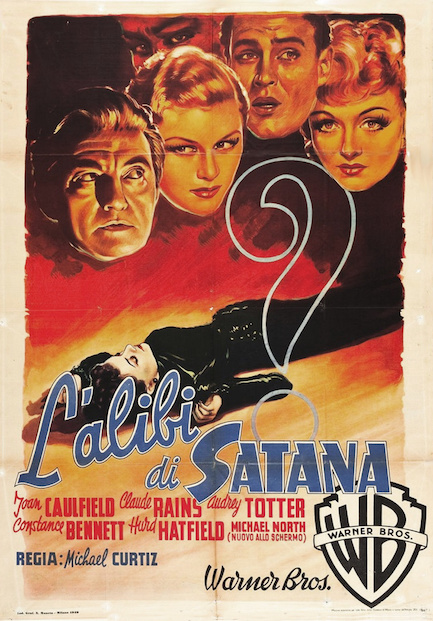 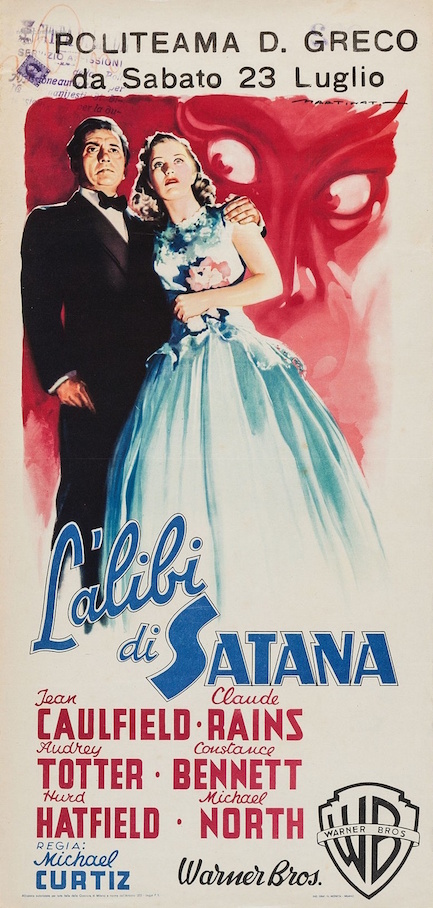
Above are a couple of beautiful Italian posters for L'alibi di Satana, better known as The Unsuspected. The set-up of this is too complicated to explain in the short form we use here on Pulp intl., but basically it's a murder mystery dealing with family jealousy, thwarted romances, inherited money, and amnesia. Despite the complexity of the script, which is derived from a Charlotte Armstrong novel, thanks to the title you can guess who the killer is by ignoring all the clues and simply picking the person with the best alibi. We know—that's a spoiler. But we bet 95% of you would have nailed it within twenty minutes anyway. The Unsuspected is still an interesting flick, though. The main attraction is Claude Rains, always great no matter the circumstances, and he's accompanied by Joan Caulfield, Audrey Totter, Constance Bennett, and others. It premiered in the U.S. in 1947, and opened in Italy today in 1949. 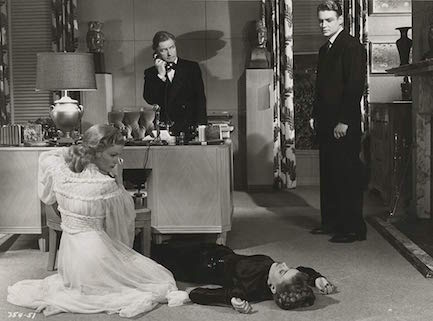 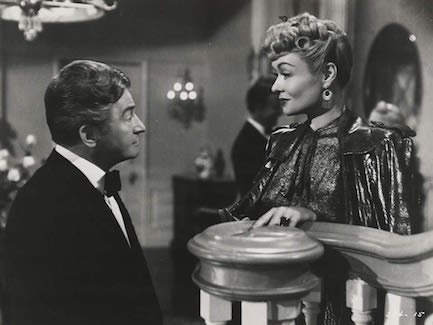 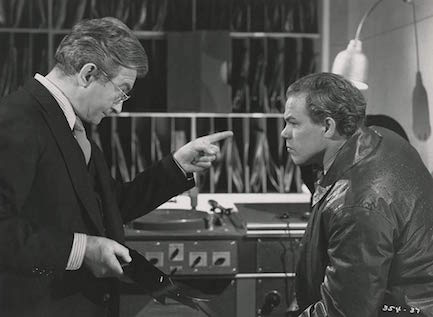 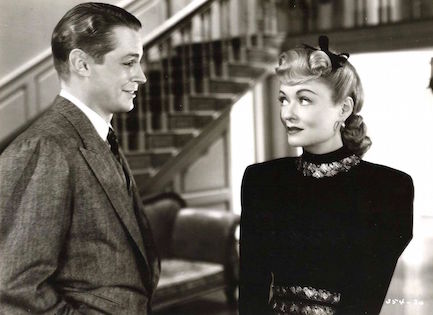 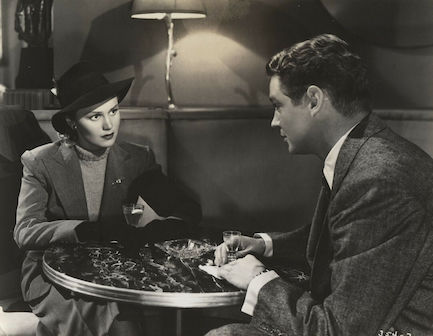 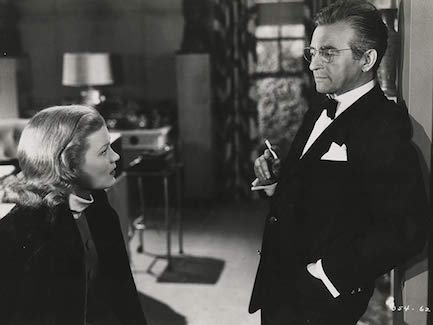
 Gangsters try to steal Robert Ryan's boxing future. 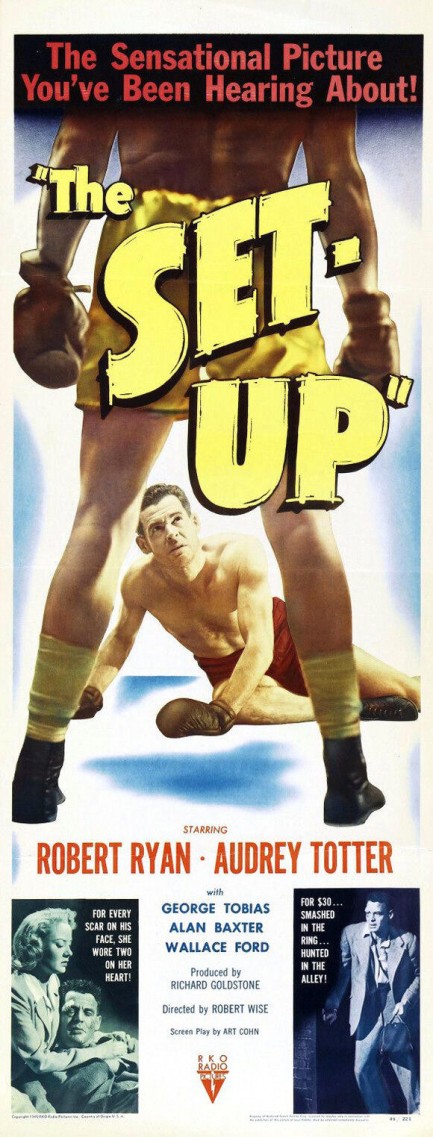
In film noir there are procedural cop movies. The Set-Up is a procedural boxing movie. It tries to take viewers behind the scenes of the violence, bloodlust, and money to focus on the nuts and bolts of the fight game. Starring Robert Ryan as an aging heavyweight and Audrey Totter as his fretful girlfriend, most of the first half of the film takes place in a claustrophobic locker room as boxer after boxer goes out for subsequent bouts of a six card program like gladiators in Rome's Coliseum. Ryan is the main event, and when his name is called the action shifts to the ring for his fight, which is shown in something close to real time.
Ryan is hoping a win over an up and coming young fighter will earn him one last shot at fortune and glory, but he has no idea the fix is in. Somebody should have told him, because if he wins the bout he'll be in heaps of trouble. This is a good flick. It was helmed by Robert Wise, has some fantastic directorial extravagances, and looks spectacular in general, like the gritty documentary photos of Arthur Weegee Fellig, which is no small feat for a film shot entirely on an RKO backlot (Weegee, incidentally, has a cameo as a timekeeper). In the realm of boxing movies The Set-Up stands toe to toe with most. It premiered in the U.S. today in 1949. 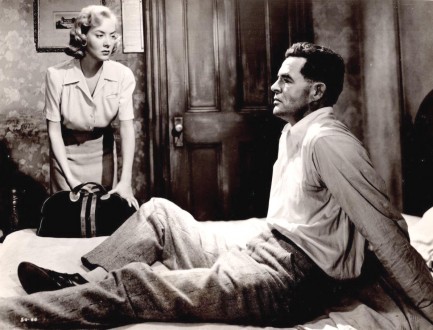 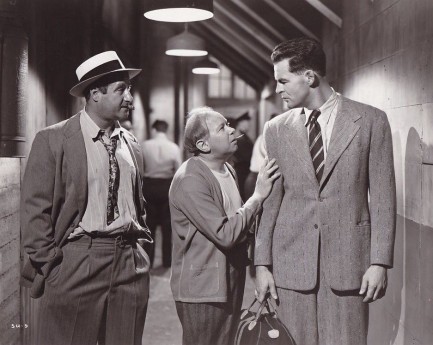 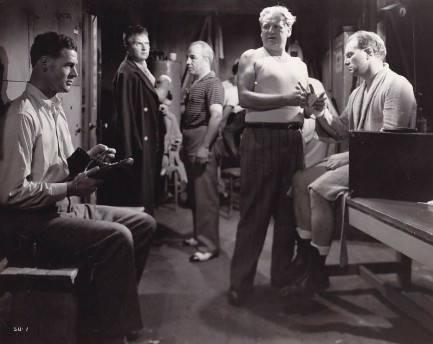 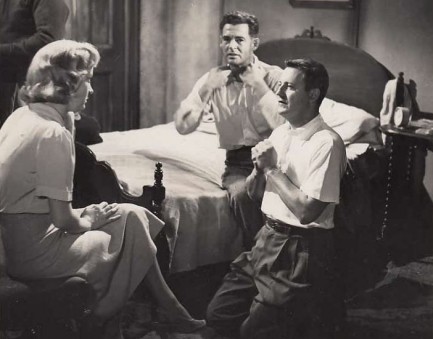 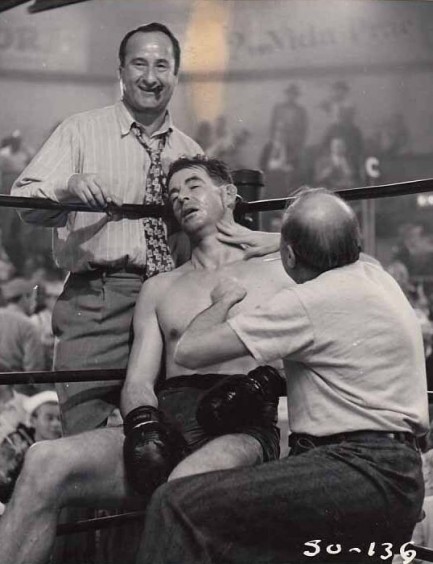 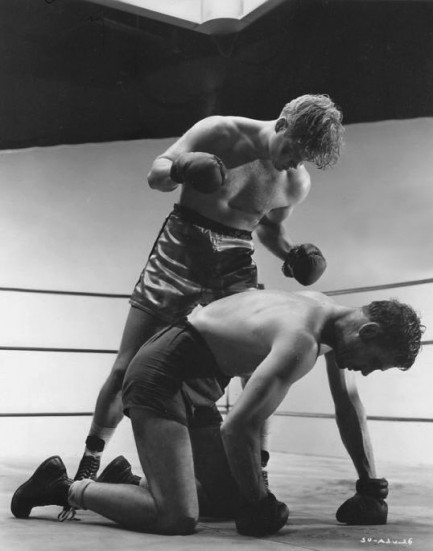 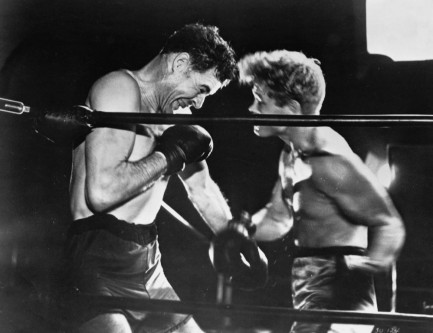 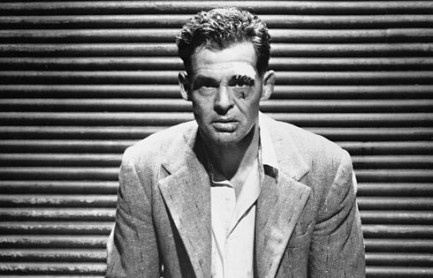 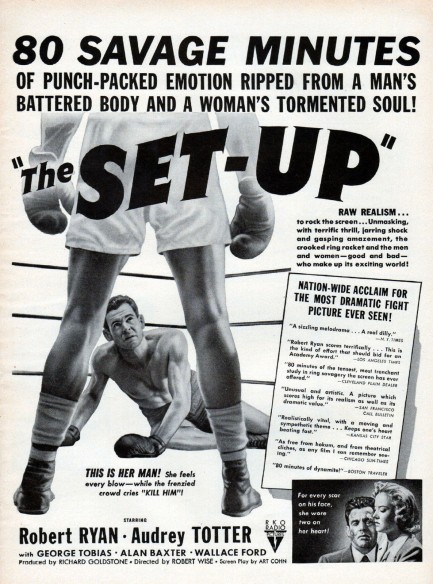
 Whoa... is the floor swaying or is that me? 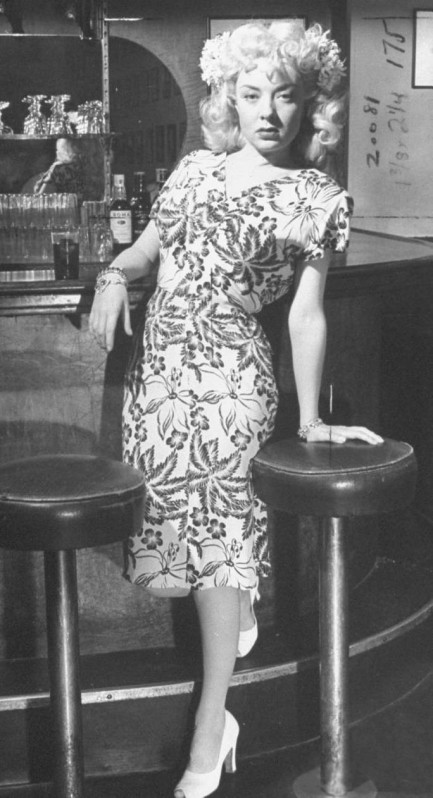
Audrey Totter isn't as well known today as she should be, considering she appeared in The Postman Always Rings Twice, The Lady in the Lake, F.B.I Girl, The Unsuspected, The Set-Up, Main Street After Dark, and Tension, but she was well appreciated in her day as a bad girl and film noir stalwart. Her career spanned radio, cinema, and television, and her life spanned ninety-five years, a good run on both counts. This promo photo of her in the typical bad girl's natural habitat—the local gin mill—was made in 1946 and appeared in Life magazine.

|
 |

The headlines that mattered yesteryear.
2003—Hope Dies
Film legend Bob Hope dies of pneumonia two months after celebrating his 100th birthday. 1945—Churchill Given the Sack
In spite of admiring Winston Churchill as a great wartime leader, Britons elect
Clement Attlee the nation's new prime minister in a sweeping victory for the Labour Party over the Conservatives. 1952—Evita Peron Dies
Eva Duarte de Peron, aka Evita, wife of the president of the Argentine Republic, dies from cancer at age 33. Evita had brought the working classes into a position of political power never witnessed before, but was hated by the nation's powerful military class. She is lain to rest in Milan, Italy in a secret grave under a nun's name, but is eventually returned to Argentina for reburial beside her husband in 1974. 1943—Mussolini Calls It Quits
Italian dictator Benito Mussolini steps down as head of the armed forces and the government. It soon becomes clear that Il Duce did not relinquish power voluntarily, but was forced to resign after former Fascist colleagues turned against him. He is later installed by Germany as leader of the Italian Social Republic in the north of the country, but is killed by partisans in 1945.
|

|
|

It's easy. We have an uploader that makes it a snap. Use it to submit your art, text, header, and subhead. Your post can be funny, serious, or anything in between, as long as it's vintage pulp. You'll get a byline and experience the fleeting pride of free authorship. We'll edit your post for typos, but the rest is up to you. Click here to give us your best shot.

|
|





 Diana Dors smacks Patrick Allen blurry in 1957's The Long Haul.
Diana Dors smacks Patrick Allen blurry in 1957's The Long Haul. Mob boss George Raft menaces Anne Francis in a promo image made for 1954's Rogue Cop.
Mob boss George Raft menaces Anne Francis in a promo image made for 1954's Rogue Cop. Bud Abbott gets aggressive with Lou Costello in 1945's Here Come the Co-Eds.
Bud Abbott gets aggressive with Lou Costello in 1945's Here Come the Co-Eds. Jo Morrow takes one from black hat Jack Hogan in 1959's The Legend of Tom Dooley.
Jo Morrow takes one from black hat Jack Hogan in 1959's The Legend of Tom Dooley. Chris Robinson and Anita Sands get a couple of things straight about who's on the yearbook committee in Diary of High School Bride.
Chris Robinson and Anita Sands get a couple of things straight about who's on the yearbook committee in Diary of High School Bride. Paul Newman and Ann Blyth agree to disagree in 1957's The Helen Morgan Story.
Paul Newman and Ann Blyth agree to disagree in 1957's The Helen Morgan Story. Verna Lisi shows Umberto Orsini who gives the orders in the 1967 film La ragazza e il generale, aka The Girl and the General.
Verna Lisi shows Umberto Orsini who gives the orders in the 1967 film La ragazza e il generale, aka The Girl and the General. What the fuck did you just call me? Marki Bey slaps Betty Anne Rees loopy in the 1974 horror flick Sugar Hill.
What the fuck did you just call me? Marki Bey slaps Betty Anne Rees loopy in the 1974 horror flick Sugar Hill. Claudia Cardinale slaps (or maybe punches—we can't remember) Brigitte Bardot in the 1971 western Les pétroleuses, known in English for some reason as The Legend of Frenchie King.
Claudia Cardinale slaps (or maybe punches—we can't remember) Brigitte Bardot in the 1971 western Les pétroleuses, known in English for some reason as The Legend of Frenchie King. Audrey Totter reels under the attentions of Richard Basehart in 1949 Tension. We're thinking it was probably even more tense after this moment.
Audrey Totter reels under the attentions of Richard Basehart in 1949 Tension. We're thinking it was probably even more tense after this moment. Anne Baxter tries to no avail to avoid a slap from heel Steve Cochran in 1954's Carnival Story.
Anne Baxter tries to no avail to avoid a slap from heel Steve Cochran in 1954's Carnival Story.
 Though Alan Ladd was a little guy who Gail Russell probably could have roughed up if she wanted, the script called for him to slap her, and he obeyed in the 1946 adventure Calcutta.
Though Alan Ladd was a little guy who Gail Russell probably could have roughed up if she wanted, the script called for him to slap her, and he obeyed in the 1946 adventure Calcutta. Peter Alexander guards his right cheek, therefore Hannelore Auer crosses him up and attacks his left in 1964's Schwejk's Flegeljahre, aka Schweik's Years of Indiscretion.
Peter Alexander guards his right cheek, therefore Hannelore Auer crosses him up and attacks his left in 1964's Schwejk's Flegeljahre, aka Schweik's Years of Indiscretion. Elizabeth Ashley gives Roddy McDowall a facial in in 1965's The Third Day.
Elizabeth Ashley gives Roddy McDowall a facial in in 1965's The Third Day. Tony Anthony slaps Lucretia Love in 1972's Piazza pulita, aka Pete, Pearl and the Pole.
Tony Anthony slaps Lucretia Love in 1972's Piazza pulita, aka Pete, Pearl and the Pole. André Oumansky goes backhand on Lola Albright in 1964's Joy House.
André Oumansky goes backhand on Lola Albright in 1964's Joy House. Frank Ferguson catches one from Barbara Bel Geddes in the 1949 drama Caught.
Frank Ferguson catches one from Barbara Bel Geddes in the 1949 drama Caught. This looks like a real slap, so you have to credit the actresses for their commitment. It's from 1961's Raisin in the Sun and shows Claudia McNeil rearranging the face of Diana Sands.
This looks like a real slap, so you have to credit the actresses for their commitment. It's from 1961's Raisin in the Sun and shows Claudia McNeil rearranging the face of Diana Sands. Gloria Grahame finds herself cornered by Broderick Crawford in 1954's Human Desire.
Gloria Grahame finds herself cornered by Broderick Crawford in 1954's Human Desire. Bette Davis, an experienced slapper and slappee, gets a little assistance from an unidentified third party as she goes Old West on Amanda Blake in a 1966 episode of Gunsmoke called “The Jailer.”
Bette Davis, an experienced slapper and slappee, gets a little assistance from an unidentified third party as she goes Old West on Amanda Blake in a 1966 episode of Gunsmoke called “The Jailer.” There are a few slaps in 1939's Gone with the Wind, so we had our pick. We went with Vivien Leigh and Leslie Howard.
There are a few slaps in 1939's Gone with the Wind, so we had our pick. We went with Vivien Leigh and Leslie Howard. Virginia Field takes one on the chin from Marshall Thompson in Dial 1119.
Virginia Field takes one on the chin from Marshall Thompson in Dial 1119. Clint Eastwood absorbs a right cross from nun Shirley MacLaine in 1970's Two Mules for Sister Sara.
Clint Eastwood absorbs a right cross from nun Shirley MacLaine in 1970's Two Mules for Sister Sara.





